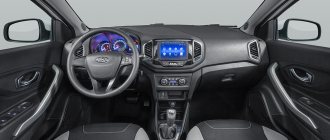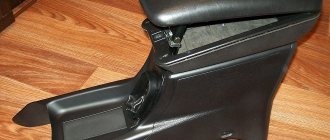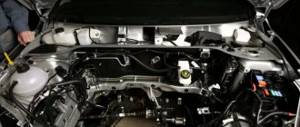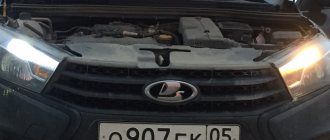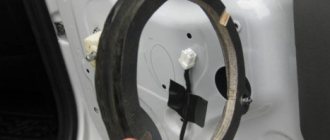Reliability and long service life of the suspension are among the priority characteristics of the car. Even at the design stage, engineers set the task of developing a suspension that would be maximally adapted for domestic roads.
The result turned out well; the design even caused delight and surprise among some car enthusiasts. The average resource of suspension elements exceeds 100,000 km. Despite a number of positive aspects, there is always a fly in the ointment.
Knocks and noises in the front suspension of Lada Vesta
- Many car enthusiasts note the appearance of a squeaking sound in the front axle area immediately after purchasing a car from a dealership. Driving through speed bumps turns into real hard labor. The culprit is the rubber bushings on the stabilizer bar.
Service station technicians do not recommend lubricating sealing products with grease or transmission oil. The creaking will go away, but for a short time, then it will resume again. To get rid of annoying squeaking, use polyurethane stabilizer bushings from Chevrolet Niva. (Cat. Art. 17012680).
- The play of the tip in the ball joint can also cause knocking. According to the regulations, replacement is carried out complete with suspension arms.
- Often inexperienced drivers confuse the creaking of suspension elements with a dull knock in the exhaust system area. The muffler mount is another defect from AvtoVAZ. The rubber retainer must be lubricated with silicone grease. The unpleasant sound will go away for a long time.
- The front suspension is knocking or rattling - contact a service station for help. Specialists identify the source of the breakdown with high accuracy. Self-diagnosis does not always bring the desired result due to the lack of special equipment.
- Do not forget that play in the chassis of the car can also be perceived as a malfunction in the suspension. Carry out diagnostics carefully and take a comprehensive approach to identifying the breakdown.
Defects of Lada
Lada Vesta has recently rolled off the assembly line and not all warranty workshops have experience in solving problems on how to eliminate knocking noises that occur in the suspension. The manufacturer constantly maintains contact with the service station and makes changes to the design. Let's consider possible malfunctions and methods for eliminating them in the front suspension of the Lada.
Car enthusiasts may be disappointed by a new car almost immediately. An unpleasant creaking and knocking sound appears when passing speed bumps. Upon analysis, it turned out that the problem was in the stabilizer bar bushings.
It is not recommended to lubricate them with grease; they will stop squeaking, but for a very short period of time, so they only need to be changed. They can be replaced with polyurethane ones from Niva Chevrolet. The bushing has catalog number 17012680. After replacement, the squeaking sound disappears.
You should know that these are not all problems; a characteristic knocking sound may occur from the front right.
This is typical when there is increased play in the right ball joint. Replacement is carried out together with the suspension arms assemblies. AvtoVAZ supplies them complete with a ball joint.
Front suspension of the Lada Vesta The main defects that occur in the front part of the Vesta car, which may cause the car to creak or rattle:
- Grinding noise in the anti-roll bar;
- The right ball joint is faulty, it starts knocking;
- The stabilizer links begin to rattle.
It is recommended that all these defects be repaired at AvtoVAZ dealerships.
When driving on an uneven road, you hear a dull knock on small bumps or a sound reminiscent of rubber friction. This problem can be eliminated by lubricating the Vesta muffler mounting with grease. Vesta's front suspension creaking may be due to worn struts.
To eliminate the defect, you just need to replace them with new ones, the problems with the suspension will be solved.
Knocks in the rear suspension of Lada Vesta
In the process of identifying a malfunction, distinguish between knocking (dull) and squeaking, rubber friction. One of the weak points of the rear suspension is the upper shock absorber mount. There is a gap between the mount and the body, as a result of which on uneven surfaces the rod hits the metal surface. The defect is typical for all Lada Vesta models, this is the factory design.
To eliminate knocking, place a rubber or asbestos gasket between the upper support and the body mount.
The following can also produce crunching noise:
- poorly tightened discs that rattle at speed;
- equipment, cargo, suitcase with tools in the trunk;
- metal cable of the parking brake lever;
- trunk lid dampers;
- locks of the rear sofa, seat backs.
Problems with noise and squeaking from the rear of the car
Creaking from the rear of the car Malfunctions can also manifest themselves as a knocking sound in the rear suspension when driving over uneven surfaces or a creaking noise from the rear. All these sounds signal a problem that needs to be solved. In order to remove it, as recommended by the factory, it is necessary to cut out the gasket and install it on the upper shock absorber support. This will eliminate knocking in the Lada Vesta suspension.
Poorly spun wheels can crunch and squeak. This often occurs on other car models and is caused by the car owner’s carelessness when changing wheels. It is urgent to stop and tighten the wheels.
Poorly packed items in the trunk of a car can make knocking and crunching noises. Before trying to eliminate suspension squeaks, you should empty the trunk of all unnecessary things and drive the car.
If there are no extraneous sounds, then the issue is resolved. Sources of extraneous noise from behind can also be minor problems, but to eliminate them you need to know them:
- The handbrake cable is not secured, just tighten the tie;
- The trunk lid dampers may make different sounds; they should be lubricated with silicone grease;
- With increased play, the trunk lid begins to rattle; lubricate and eliminate the play;
- The locks of the rear seat back may squeak, just lubricate and wrap a little electrical tape;
- Things are poorly packed in the trunk.
The front and rear suspension of Vesta differs significantly from the one that AvtoVAZ used on Grant, Priora, Kalina, etc. All the reviews tell us that the new chassis design is better than before. However, during the first months of operation, the owners began to notice extraneous noises (knocks, creaks, rattles, crunches) in the Vesta’s front and rear suspensions, which occur when driving over speed bumps or other road irregularities.
Loose wheel bolts
For various reasons, personal carelessness, including insufficient tightening of bolts, contributes to the appearance of extraneous sound. If you detect an uncharacteristic sound, check the tightening of the bolts yourself. If you do not have a wheel wrench, contact a service station for help.
After tightening, be sure to check that the wheel does not knock and make sure that the cause has been eliminated.
We do not recommend doing your own repairs while the machine is under warranty. Otherwise, it may be classified as a breach of contract by the consumer. It is not uncommon for a factory warranty to be voided prematurely.
Wear of stabilizer bushings
The first sign of “fatigue” of the stabilizer sealing bushings is a dull knock when overcoming a speed bump. Even in Lada Vesta, the manufacturer saves on materials and uses the cheapest ones. As a result, the service life of the bushings is short; creaking of the Lada Vesta suspension appears after several tens of thousands of mileage.
Other signs of bushing wear:
- knocking in the area of the front axle when the car rolls;
- beating in the steering wheel at speeds over 60 km/h;
- play in the steering wheel when maneuvering;
- arbitrary deviation of the machine from a given course. Car enthusiasts say that it “takes away” to the side.
The final conclusion will be given by a mechanic after conducting a comprehensive diagnosis.
Self-diagnosis of problems
If there is a knocking sound in the steering wheel or the Vesta suspension rattles, you should immediately contact the dealership.
If this is not possible, you can diagnose and identify problems yourself. To do this, just hang up the Lada wheels and do the following work:
- Let's rock the wheels in different planes; if play is felt when the brake pedal is released, this indicates that the hub bearing has failed;
- If there is a problem with the suspension, play is felt regardless of whether the brake pedal is pressed or released;
- If the ball joint is defective or the strut is poorly secured, play is felt in the vertical plane;
- Failed tie rod ends are accompanied by play in the horizontal plane.
Sequence of actions when replacing roll bar bushings
Catalog number - 8450006748, cost of original spare parts - from 350 rubles/piece. As an alternative, use polyurethane bushings from Chevrolet Niva (17012680).
Required tools:
- TORX 40 wrench, heads “13” and “16”;
- knob;
- extension wrench;
- torque wrench;
- new bushings, preferably polyurethane ones, as they have a longer service life.
Step-by-step instruction:
- We hang the front part of the car with a jack and use a hydraulic lifting mechanism.
- Unscrew the steering gear casing (head at “10”).
- We unscrew the steel brackets that secure the rubber bushings (the key is set to “13”).
- Unscrew the front bolts (T40 key) and remove the bushings.
- We insert new ones and assemble the structure in reverse order.
Tighten the bolts with a force of 2.0 kgf/m.
Grinding, creaking in the front suspension
A dull sound, as if the racks are touching the plastic, or a creaking sound reminiscent of rubber friction. The reason is the poor quality of the stabilizer bushings (No. 8) or insufficient lubrication of the muffler mounts .
It is enough to lubricate the gingerbreads (muffler mounts) with grease. There is no point in lubricating the rubber bushings of the stabilizer, because... This doesn't last long. According to reviews from Vesta owners, the problem of front suspension squeaking can be solved by replacing the standard rubber stabilizer bushings with polyurethane bushings (catalog number: 17012680). Or install analogue bushings.
Wear of stabilizer link joints
Catalog number of the original stands (bones) - 8450006750, length - 283 mm. Due to poor-quality road surfaces, pins (hinges) often fail prematurely.
Replacing the “bones” yourself is not at all difficult if you follow the instructions for using the technical device.
Required tools:
- wrench 16, 19, Torx 30;
- a set of new “bones”.
Step-by-step instruction:
- Jack up the car and remove the wheel on the right.
- Unscrew the upper and lower fastenings of the “bone”.
- We insert a new one, tighten the nuts, and screw the wheel.
- By analogy, we repair on the left.
Wheel bearing noise
At the initial stage of wear, the noise is practically inaudible. The appearance of extraneous sound in the cabin is a sign of moderate wear.
To verify that the bearing is faulty, it is enough to drive onto an open highway and accelerate to 50 km/h. Gradually rotate the steering wheel left and right. When turning to the left, the right bearing is worn out, and when turning to the right, the left bearing is worn out.
It often happens that a hum or rumble is heard on both sides, then the left and right bearings must be replaced, respectively.
Ball joint knock
After 60 - 65 thousand kilometers, owners note the appearance of a knocking sound in the area of the axle shaft. Most often when turning at low speed.
The tip of the ball joint is rolled into a plastic sleeve. During the systematic operation of the car, the moving surfaces wear out and play forms.
The process of replacing the ball joint yourself is not difficult, but be careful not to violate the installation technology.
To verify that the ball is faulty, just jack up the side of the car. Loosen the wheel up and down, the presence of knocks and clicks will be a sign of wear on the ball joint.
Installation
It is extremely simple. As practice shows, it is not even necessary to remove the wheel - you can work by simply jacking up the car. After you place Vesta on the jack, you need to unscrew the 2 bolts that secure the stand. There are no nuts on the interior side, which greatly simplifies the task and makes it possible to work independently.
When the bolts are unscrewed, all that remains is to install the spacer and screw them back.
It is worth noting that some people separately purchase bolts longer than the standard ones in order to be sure of the quality of the fixation, but this is not necessary. Also, some owners treat the components with Movil or other lubricant.
The process of self-installation of spacers is clearly demonstrated in the video
As you can see, installing spacers under the supports of the rear shock absorbers of the Lada Vesta is quite simple, and it is by no means necessary to buy them, although the price of such products is low and their purchase will not hit the budget. But with spacers, the cabin becomes quieter, especially when driving over bumps.
Support bearing knock
Often, car enthusiasts perceive the shock of the shock absorber rod as the knock of the wheel bearing. This can be explained by the design of the rack: two cylinders and a metal rod.
During systematic use, the bypass valves wear out and the strut does not dampen vibrations. With a sharp push, a blow occurs, which is perceived as a knock of the support bearing.
To guarantee that the latter is faulty, it is necessary to conduct a comprehensive diagnosis. It’s not difficult to do this yourself; in the transport position of the car, it’s enough to bleed the strut with a few presses on the car’s fender. After sharp pressure, the car must stabilize on its own, otherwise the shock absorber strut is faulty.
If there are no complaints about the shock absorber, then you are guaranteed to replace the support joint. The process is quite complex and requires minimal knowledge in servicing equipment. Unprofessional intervention does not guarantee full functionality of the mechanisms.
In order to carry out comprehensive diagnostics and replace worn-out equipment, contact a certified service station for help.
Ways to eliminate knocking in the front (rear) suspension of a Lada Vesta car
If you have minimal experience in servicing equipment, carry out repairs yourself. Service station technicians do not recommend independent repairs during the period of the vehicle’s factory warranty.
After the appearance of third-party noises and squeaks, the car enthusiast can carry out initial diagnostics and assess the general technical condition of the car or unit. With the results, contact the workshop to make a decision. The reasons for wear of chassis and transmission elements are varied, ranging from violation of maintenance deadlines to defective parts.
Review of Manufacturer Prices
| Catalog number / Size / Diameter | Price in rubles |
| Original | |
| 17012680 (inner diameter 21.5 mm.) | From 400 |
| 8450006748 | From 400 |
| Analogs | |
| Polyurethane from Chevrolet Niva 2123 (17012680) | From 350 |
| Polyurethane for Lada Vesta from Kia Rio (548132K100, 548141G000) | From 550 |
| 54813-2K100 (diameter 21.5 mm.) | From 550 – 600 |
| KSBSOULF (diameter 21.5mm) – new sample | From 550 – 600 |
| Vesta front left / right (8450006750), stabilizer struts length 275 mm | From 700 |
| RENAULT Logan suspension mount (30768) | From 130 |
| Nut RENAULT 7703034221 | From 300 |
| Bracket 8450006747 | From 350 |
| Rod 8450006748 | From 450 |
| Toyota Rav4 (48820-42020), length 285 mm | From 2500 |
| CTR (CLT50) | From 650 / piece |
| Renault, SASIC, SIDEM, LEMFORDER, length 275 mm | From 400 |
| Alfa – Fiat – Lancia 46413122 | From 370 |
| MONROE: L15600 | From 380 |
| Multipla, Lybra | From 350 |
| Kia Rio (548132K100) | From 370 |
| Bracket (548141G000) | From 250 |
*prices are as of April 2, 2019.
Conclusion
If you notice a third-party creaking, knocking, or rattling noise in the suspension, don’t panic. Malfunctions are a natural process. At the initial stage, it is important to correctly identify the source of the breakdown and its location.
If you do not have a special tool, such as mounting tools or TORX keys, contact a service station. It is extremely difficult to repair a car with your bare hands. Regarding the manufacturer of spare parts, the final decision rests with the owner of the technical equipment. The domestic manufacturer is not inferior in quality to foreign analogues. In this case, it is not advisable to overpay for the brand.
Reviews
| № | Positive |
| 1. | Stepan Vasilyevich , 42 years old (otzovik.com): the suspension is mounted on a subframe, the levers and steering knuckles are of a new shape. Obstacles on the road are overcome smoothly, without impacts. |
| 2. | Gennady Semenovich , 39 years old (www.zr.ru): at speeds up to 125 km/h the suspension works as comfortably as possible. The problems start from above. |
| 3. | Timofey , 22 years old (autobann.su): pleased that gas shock absorbers are installed by default. This is just right for the urban cycle. |
| 4. | Kirill , 33 years old (lada-vesta.net): before the Lada Vesta I had a Granta, it has an old type suspension design. Vesta uses frame technology. The steering rack and stabilizers are fixed to the beam. |
| 5. | Semyon Nikolaevich , 44 years old (otzovik.com): my positive review of the chassis and suspension of the Lada Vesta. The car is in its second year - no complaints, minor bumps are absorbed silently. |
| 6. | Lev Nikolaevich , 45 years old (www.zr.ru): I live in a rural area, you know what the roads are. The suspension works great. My recommendations to motorists. |
| 7. | Dmitry , 20 years old (autobann.su): springs are installed separately from shock absorbers, semi-independent type with a number of improvements that were so lacking in previous generations. |
| 8. | Mikhail Gennadievich , 43 years old (lada-vesta.net): the angle of inclination of the front pillars is 5 °, which has a positive effect on the handling characteristics of the car. The steering from the second generation Renault Megane is better than its domestic counterpart. |
| 9. | Kirill , 40 years old (otzovik.com): good car, good build, no comments on the chassis or transmission. |
| 10. | Petr Semenovich , 42 years old (www.zr.ru): the car is three years old, there are no comments on the components, I systematically carry out technical inspections and diagnostics, and treat the equipment with care. |
| 11. | Alexander , 35 years old (autobann.su): during two years of active operation of the car, I replaced the rubber bushings on the stabilizers once. I am satisfied with the build quality of the domestic car. |
| Negative | |
| 12. | Konstantin Stanislavovich , 43 years old (www.zr.ru): the chassis has not lasted even two years, it thumps, the suspension creaks in the cold. The officials said that this is not a warranty case and they cannot help. I replaced the rubber bands myself with polyurethane ones. |
| 13. | Vitaly , 27 years old (otzovik.com): instead of standard rubber bands, I installed polyurethane ones from Chevrolet Niva. The service life of the last 60 - 70 thousand km. As it turned out, the reason for the knocking was premature wear of the rubber seals of the stabilizer link. |
| 14. | Grigory Vladislavovich , 45 years old (autobann.su): a model with obvious defects, after purchase it needs a comprehensive re-upholstery of components, mechanisms, and partial noise reduction. |
Rear (front) suspension of Lada Vesta SV cross and sport versions - differences from the usual one
The modernization of the Lada Vesta SV Cross received rear springs increased by 9 mm. Vesta SV Cross, in addition to springs, received redesigned shock absorbers and a retuned chassis, and its track became 14 mm wider than the standard one. Despite the improvements, knocking in the front suspension of the car also occurs.
The suspension of the Lada Vesta Sport deserves close attention. The diameter of the front shock absorber rod, working cylinder and strut housing was increased. Production was carried out not by SAAZ, but by Demfi, and the rear suspension also increased in size. Changes affected the rod, working cylinder and housing. The hub is now mounted with five bolts, and larger cast steel steering knuckles provide crisp, precise wheel turning.

